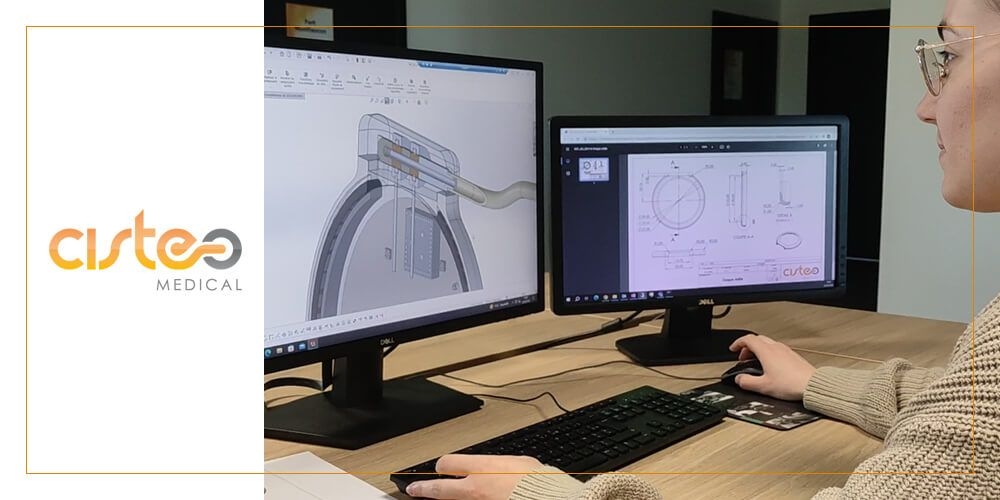
An embedded system has a number of limitations that Cisteo MEDICAL seeks to overcome, such as space requirements and autonomy. The company supports its customers at every stage, from design to industrialisation, but the effectiveness of the support is all the greater when you start from the idea. Cisteo MEDICAL is also involved in the design of AIMDs.
Thanks to its mechatronics design office, Cisteo MEDICAL is able to optimise a device through a global mastery of skills and to meet the objectives of start-ups, namely performance, autonomy and economy.
Thanks to its mechatronics design office, Cisteo MEDICAL is able to optimise a device through a global mastery of skills and to meet the objectives of start-ups, namely performance, autonomy and economy.
Integrating mechatronics into the design of medical devices
Experienced in the design of active implantable medical devices, Cisteo MEDICAL puts its research and development skills at the service of start-ups, drawing on a wide range of technologies. One example of this is its expertise in mechatronics.
Mechatronics is defined as the combination of technologies such as mechanics, electronics, IT and fluidics. This field of engineering enables us to design embedded systems that meet the current challenges of AIMDs (active implantable medical devices).
Mechatronics is defined as the combination of technologies such as mechanics, electronics, IT and fluidics. This field of engineering enables us to design embedded systems that meet the current challenges of AIMDs (active implantable medical devices).
Miniaturisation, a major challenge for active implantable medical devices
Miniaturising a medical device does not mean reducing its dimensions in a homothetic way. Meeting this size reduction requirement generally means redesigning the medical device. To achieve this objective, Cisteo MEDICAL relies on its micromechanical skills and its prototyping workshop to ensure feasibility.
For example, today, the use of fibre optics for signal transmission represents an advantage for patient safety and comfort (transparent signal for MRI). Cisteo MEDICAL has mastered the use of 2 to 5 tenths fibre and can design medical devices taking this advantage into account. The use of biosensors also enables us to make progress in this race for miniaturisation. Projects have enabled us to research and adapt certain biosensors to monitor data for cancer diagnosis.
Moving from open surgery to minimally invasive surgery is another benefit of the miniaturisation of medical devices. With this as a starting point, our research focuses first on the implant, what it should do and how it should be redesigned, and then we think about how it should be delivered and what instrumentation tools are needed. For this overall design, Cisteo MEDICAL relies on its mastery of atypical, adapted and adaptable techniques.
This strong regional culture in microtechnology, derived from watchmaking, is omnipresent in Cisteo MEDICAL's local ecosystem and enables the company to draw on a network of research centres, universities, schools and companies.
For example, today, the use of fibre optics for signal transmission represents an advantage for patient safety and comfort (transparent signal for MRI). Cisteo MEDICAL has mastered the use of 2 to 5 tenths fibre and can design medical devices taking this advantage into account. The use of biosensors also enables us to make progress in this race for miniaturisation. Projects have enabled us to research and adapt certain biosensors to monitor data for cancer diagnosis.
Moving from open surgery to minimally invasive surgery is another benefit of the miniaturisation of medical devices. With this as a starting point, our research focuses first on the implant, what it should do and how it should be redesigned, and then we think about how it should be delivered and what instrumentation tools are needed. For this overall design, Cisteo MEDICAL relies on its mastery of atypical, adapted and adaptable techniques.
This strong regional culture in microtechnology, derived from watchmaking, is omnipresent in Cisteo MEDICAL's local ecosystem and enables the company to draw on a network of research centres, universities, schools and companies.
Improving autonomy of AIMD, a major challenge for patients
The choice of energy source has a major impact on patient comfort and safety. Medical devices are evolving towards greater performance, reliability and durability.
The challenge in terms of medical device design is to be able to optimise and save energy and use it intelligently. Optimising mechanical efficiency (reducing displacements, forces and friction) combined with research into autonomous electrical components (on-board power supply, continuous recharging) enables the product promise to be achieved.
Thanks to a combination of technologies, mechatronics can optimise the performance of a battery in particular.
The challenge of connectivity for active implantable medical devices
The benefits of AIMD lie in the way data is tracked and managed by healthcare professionals. The aim is to be able to tailor treatment to the patient and simplify the patient's care pathway, particularly through remote monitoring.
Mechatronics makes it possible to design communicating on-board systems. These send live data to an external interface such as an iPad, for example, and can in turn receive operating modifications to adapt to changes in the patient.
Cisteo MEDICAL was involved in the design of a complete radio frequency and optical communication system, which avoids the need for antenna communication.
While following the standards of wireless communication in the medical field, Cisteo MEDICAL designs the visual interfaces and programmes the applications enabling the data to be received and interpreted.
Mechatronics makes it possible to design communicating on-board systems. These send live data to an external interface such as an iPad, for example, and can in turn receive operating modifications to adapt to changes in the patient.
Cisteo MEDICAL was involved in the design of a complete radio frequency and optical communication system, which avoids the need for antenna communication.
While following the standards of wireless communication in the medical field, Cisteo MEDICAL designs the visual interfaces and programmes the applications enabling the data to be received and interpreted.
